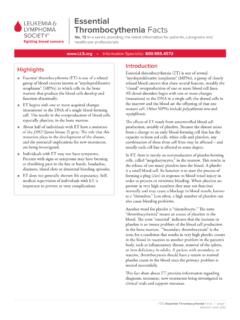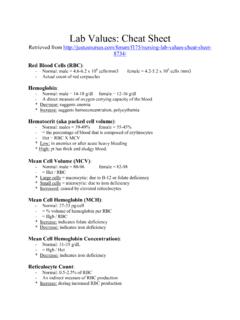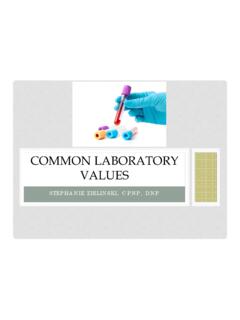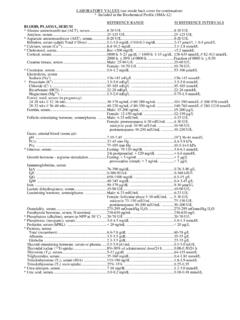Transcription of UNDERSTANDING MULTIPLE MYELOMA AND LABORATORY …
1 UNDERSTANDING MULTIPLE MYELOMA AND LABORATORY VALUES Benjamin Parsons, DO Gundersen Health System Center for Cancer and blood Disorders La Crosse, WI MULTIPLE MYELOMA is a cancer of the immune system, in particular of the plasma cell a mature b lymphocyte. Plasma cells produce antibodies(immunoglobulins) that normally protect us from infection but in MULTIPLE MYELOMA these are nonfunctional and are called paraproteins. All of the paraproteins from any one individual are monoclonal (identical) because the MYELOMA cells are identical clones of a single plasma cell. UNDERSTANDING MULTIPLE MYELOMA THE IMMUNE SYSTEM Cellular Immune System White blood Cells: Granulocytes Lymphocytes: T cells Humoral Immune System B cells and antibodies AB BASIC STRUCTURE TYPES OF ANTIBODIES oTypes of Heavy Chains oIgG oIgA oIgM oIgD oIgE oTypes of Light Chains oKappa oLambda WHAT HAPPENS IN MULTIPLE MYELOMA ?
2 Malignant plasma cell makes a clone of itself and these malignant plasma cells, or MYELOMA cells, accumulate in the bone marrow. The malignant plasma cells secrete an antibody, or immunoglobulin, called the M- protein, or M- spike, or paraprotein or MYELOMA protein. It can be detected in the blood and/or the urine of most MYELOMA patients. LABORATORY TESTING FOR MULTIPLE MYELOMA Why perform lab tests? Goals: Diagnosis Determine severity and spread (staging) Monitor progress of disease Detect complications Monitor the effectiveness of treatment COMPREHENSIVE METABOLIC PANEL A group of tests used to evaluate kidney and liver function, electrolyte status, and to determine calcium and total protein levels Total protein Calcium Creatinine OTHER CHEMISTRY TESTS IMPORTANT IN MULTIPLE MYELOMA Beta2-microglobulin Serum albumin level Serum Viscosity COMPLETE blood COUNT (CBC) Hemoglobin / Hematocrit - measure of red blood cells - red blood cells carry oxygen White blood Cell Counts -absolute neutrophil counts (ANC)
3 - fight off and protect against infection Platelet Counts -platelets are responsible for stopping bleeding and blood clotting QUANTITATIVE IMMUNOGLOBULINS Measures amounts of the different immunoglobulins MYELOMA protein will be an IgG or IgA, or less commonly IgD or IgE Levels will help monitor the course of the disease Important to be aware of the levels of the normal (non- MYELOMA ) immunoglobulins PROTEIN ELECTROPHORESIS AND IMMUNOFIXATION Protein electrophoresis separates the proteins in a blood or urine sample into several groups based on their size and electrical charge. In most patients with MM, large amounts of an abnormal immunoglobulin protein (M-spike) will appear as a large peak on the graph.
4 Immunofixation is done to identify the specific type of protein that is being produced by the malignant plasma cells. The amount of protein produced may vary throughout the course of the disease, but the type generally will remain the same. normal SERUM PROTEIN ELECTROPHORESIS PATTERN Figure 1 Typical normal pattern for serum protein electrophoresis. ABNORMAL SERUM PROTEIN ELECTROPHORESIS PATTERN Figure 2 Abnormal serum protein electrophoresis pattern in a patient with MULTIPLE MYELOMA . Note the large spike in the gamma region. IMMUNOFIXATION ELECTROPHORESIS (IFE) SERUM FREE LIGHT CHAINS (FLC) OR FREELITE ASSAY Measures the amount of free light chains in the serum ( blood ).
5 In normal circumstances, plasma cells produce an excess of light chains compared to heavy chains. A small amount of these light chains will not become incorporated into intact immunoglobulins. These are free light chains and are released into the blood . SERUM FREE LIGHT CHAINS (CONT D) Most patients with MULTIPLE MYELOMA produce increased amounts of either kappa or lambda free light chains, which can be measured in the blood . Consequently, the ratio of kappa to lambda light chains is abnormal in most patients and is a sensitive indicator for this disease. This test may be used to monitor progression and/or treatment. BONE MARROW ASPIRATE AND BIOPSY Most LABORATORY tests for MULTIPLE MYELOMA provide indirect information about the amount of tumor present, by measuring proteins that are secreted by the tumor into the blood and/or the urine.
6 These tests do not provide the same information as looking at the tumor itself. The MYELOMA cells are usually only found inside the bone marrow. BONE MARROW ASPIRATE AND BIOPSY (CONT D) Small fragments of bone marrow cells can be withdrawn with an aspirate needle, and a small core of bone and marrow is often removed at the same time with a different type of needle. Both tests are done to determine how much of the normal bone marrow is replaced by MYELOMA cells. Additional, specialized testing (cytogenetics and FISH) can be performed which can provide information about the biology of the tumor itself. UPDATED IMWG CRITERIA FOR DIAGNOSIS OF MULTIPLE MYELOMA *C: Calcium elevation (> 11 mg/dL or > 1 mg/dL higher than ULN) R: Renal insufficiency (creatinine clearance < 40 mL/min or serum creatinine > 2 mg/dL) A: Anemia (Hb < 10 g/dL or 2 g/dL < normal ) B: Bone disease ( 1 lytic lesions on skeletal radiography, CT, or PET-CT) Rajkumar SV, et al.
7 Lancet Oncol. 2014;15:e538-e548. MGUS M protein < 3 g/dL Clonal plasma cells in BM < 10% No MYELOMA defining events Smoldering MYELOMA M protein 3 g/dL (serum) or 500 mg/24 hrs (urine) Clonal plasma cells in BM 10% to 60% No MYELOMA defining events MULTIPLE MYELOMA Underlying plasma cell proliferative disorder AND 1 or more MYELOMA defining events 1 CRAB* feature Clonal plasma cells in BM 60% Serum free light chain ratio 100 > 1 MRI focal lesion RESPONSE IMWG CRITERIA CR Negative immunofixation on the serum and urine and disappearance of any soft tissue plasmacytomas and < 5% plasma cells in bone marrow VGPR Serum and urine M-protein detectable by immunofixation but not on electrophoresis or 90% reduction in serum M-protein plus urine M-protein level < 100 mg/24 h PR 50% reduction of serum M-protein and
8 Reduction in 24 hours urinary M-protein by 90% or to < 200 mg/24 h If the serum and urine M-protein are unmeasurable,5 a 50% decrease in the difference between involved and uninvolved FLC levels is required in place of the M-protein criteria If serum and urine M-protein are not measurable, and serum free light assay is also not measureable, 50% reduction in plasma cells is required in place of M-protein, provided baseline bone marrow plasma cell percentage was 30% In addition to the above listed criteria, if present at baseline, a 50% reduction in the size of soft tissue plasmacytomas is also required GETTING TO MINIMAL RESIDUAL DISEASE: NEW DEFINITIONS FOR CR 1 x 1012 Stringent CR Molecular/flow CR Cure?
9 Disease burden Newly diagnosed 1 x 108 1 x 104 CR 0 0 6 12 18 24 30 36 42 8-Color Flow[1] Next-Gen Sequencing[2] TTP (%) 100 80 60 40 20 0 100 150 0 50 P = .001 n = 26 n = 36 TTP (CR Pts) MRD- MRD+ MRD- MRD+ Overall Mos PFS (Proportion) Mos PFS (CR Pts After First-line Therapy) PFS 1. Roussel M, et al. J Clin Oncol. 2014;32:2712-2717. 2. Martinez-Lopez J, et al. blood . 2014;123:3073-3079. METHODS FOR ASSESSING MINIMAL RESIDUAL DISEASE TO PREDICT OUTCOME ROLE OF MRD ASSESSMENT Remains a research tool, but indications are that lower levels of MRD predict for better outcomes Can contribute to better definition of response Potential to monitor efficacy of therapy Best, easily exportable method and optimal time point is still under investigation Even pts who achieve MRD- state can relapse, so all may not be able to stop therapy Unsure if changing therapy based on depth of response alters survival outcomes, unsure of next steps for MRD.

















